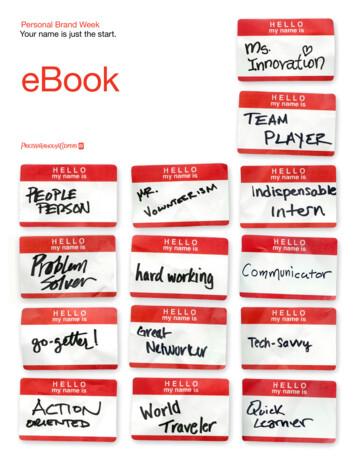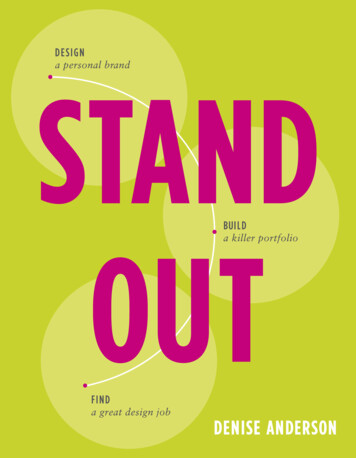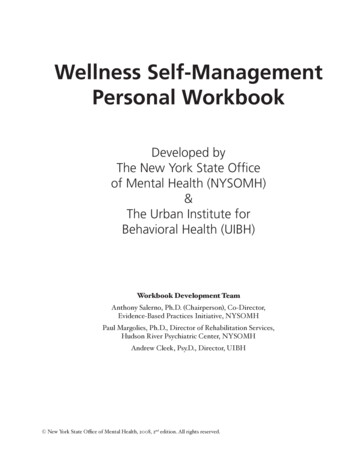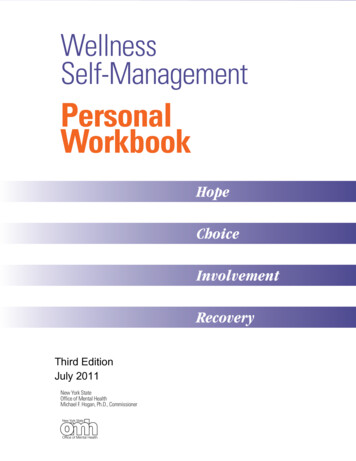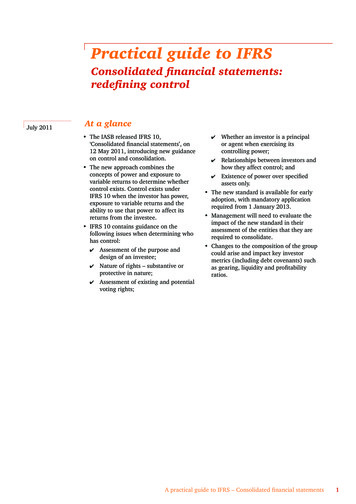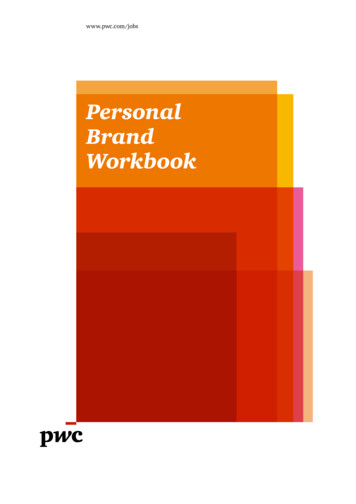
Transcription
www.pwc.com/jobsPersonalBrandWorkbook
Personal Brand workbookWelcome to your personal brand experienceThis personal brand experience is your opportunity to learn more about yourself, soyou can make decisions and plans that maximize your university experience andchart a course for your career. It will also help you position yourself, so you can reachyour goals.What’s your brand?In short, it’s your reputation. Each interaction you have with others has theopportunity to create a memorable experience, teaching them what they can expectfrom you. When you’re consistent in delivering those experiences, you build a strongreputation. Delivering your brand clearly and consistently across a wide audiencehelps open doors to opportunities. Your brand becomes your personal calling card—aunique promise of value; a distinct and authentic representation of you. In buildingyour personal brand, you will define your individuality, maximize your strengths andmanage your choices now to create future opportunities.Step up to stand outPwC has created a personal brand experience to help you find and showcase yourstrengths so you can stand out from the crowd. By tapping into your unique skills,talents and passions, you can leap off the pages of your resume and top of mind toyour recruiters. Use the activities offered here to take charge of your professionalsuccess—stand out while being your best self.Good luck and enjoy the journey.2
YourPersonalBrandDefine yourX FactorUnderstand yourwhY FactorEliminate yourZzz FactorReady,set,Show
YourPersonalBrandDefine yourX Factor
Personal Brand workbookUnleash your super skillPeople with strong brands are clear about who they are. They know and maximize theirstrengths. Here, we give you the opportunity to uncover and define your skills and strengths.You’ll be using a three-step process, Document, Distil and Validate.DocumentTo help guide you through this exercise, answer the questions below:1. What are the strengths that others acknowledge in me?2.2. When working on a team, what roles do I seek to fulfil?3. When faced with an overwhelming obstacle, what are my “go to” skills to overcome it?4. What was the most successful project I ever tackled and what made me successful?5. What was the most important team role I ever fulfilled and why?5
Personal Brand workbookDistilTo deeper your introspection, answer the questions below:1. What strengths and skills came up over and over again?2. Which are my motivating skills—the skills that excite me?3. What are my burnout skills—the skills I’ve mastered but would rather not use every day?4.4. Which strengths and skills are going to be most helpful in achieving my career goals?5. What skills are missing? What skills would I like to build but have not yet had theopportunity to practice?6
Personal Brand workbookBased on your responses to the previous questions, document your top five strengths—yoursuper skills. For example, you might use words like “creative,” “relationship-creator,” or“make the complex simple.” Then, you can start to validate your self-perception withfeedback from others.2.1.you3.4.5.ValidateUp to now, the exercise has been focused on your own perceptions. Now, it’s time to validatewhat you documented about yourself. Do others experience your super skills? Would theyagree with your assessment? You have a couple of options for completing this part of theprocess:Option 1Post the following to your Facebook wall: As part of PwC’s Personal brand experience, Icompleted an exercise to help me unearth my strengths. I came up with “Strength 1, strength2, strength 3.” What do you think are my greatest strengths?Option 2Ask your friends, professors, and others in your brand community (unprompted) what theythink sets you apart from others, then compare their responses to your self-assessment. Youcould do this in person or via email or social media, whichever you think may give you themost honest responses to help you complete your profile. If you choose email or social media,you can also consider setting up a free and anonymous survey using a tool such as SurveyMonkey.7
Personal Brand workbookConquer your weakest pointStress can leave you depleted. It can weaken your immune system, affect your sleep and drainyour adrenals while impacting every facet of your life, your relationships and your success. Itcan also have a negative impact on your personal brand.Stress is the body’s response to a threat or demand such as homework, a test, applying forcollege, going on an interview, dating, being in an argument, unresolved conflict, lack ofsleep, lack of money, a dentist appointment or being late.One way to help manage your stress is to be clear about the who, what, when, where, why andhow of your stress. Once you have figured out some of your stress triggers, you canimplement stress-management techniques designed to best address your specific stressorsand symptoms.DocumentSome stressors are on-going, chronic and may be predictable. Others are unexpected,potentially life-changing, and often out of your control. Even when you’re the person whocontrols the decision that leads to stress, it may be no less stressful. But with warning, youhave some choices about how to react.Reflect on the last 12 months of your life to answer the questions below.What key changes have you experienced in the past 12 months?Please, list them here. For each change, place a check mark next to C if it was in yourcontrol and place check mark next to O if it was out of your control (e.g., change in livingarrangements, started freshman year of college, loss of financial security, loss of a lovedone, etc.).1.CO2.CO3.CO4.CO5.CO8
Personal Brand workbookDistilWhat are your stress triggers that are likely to show up repeatedly in your life? Often theseare the things within your control, or at the very least, under your influence. Sometimes theseare things that fall short of your expectations for yourself and others and sometimes they areviolations of your values. Paying close attention to what causes stress will be the first stepdown the yellow brick road to finding the cure.1. Things you do that cause you stress (e.g. late to class, unprepared, overcommitting,people pleasing, money management, conflict management, etc.)2. Things that other people do that annoy you (e.g. being late, gossiping, not pulling theirweight, sloppy work, borrowing money, arguing)ValidateTaking a proactive approach to either prevent or mitigate those stressors that cause chronicor repeated stress will likely address 80% of the stressors in your everyday life.Consider these three actions:1. Talk with friends to share best ideas on stress reduction.2. Go online to find sites that focus on stress reduction.3. Check out the stress tips below and select some options you will put to the test now. If they work, youwill have lowered your stress. If they don’t, try another method.To eliminate unnecessary stress: Set an alarm to prompt you to leave for class/appointments with time to spare. Block time on your calendar for the preparation that must be done in advance of a due date or meeting. Schedule a 10-15 minute buffer between meetings or classes to allow time for a last minute note, a phonecall or closure of an activity to avoid loose ends or a series of unfinished promises to do later. Set clear expectations with people in your life who are perpetually late or inconsiderate. Great boundariesmake great relationships. Commit to things that are in synch with your values.9
Personal Brand workbookTo build your stress coping reserves: Sleep is the best natural rejuvenator for your body, brain and mood. Go to bed earlier in 15minute increments. The sleep you get before midnight takes advantage of your body’snatural cycles for deepest sleep. Add a warm bath or shower before bed and you will sleepmore soundly. Light and heat impact sleep quality and quantity. Darken and cool your bedroom and turnoff your electronics. Blue light from electronics interferes with sleep quality up to twohours after exposure. Take a walk and move your body at least 30-60 minutes a day—especially when your dayis filled with lots of sitting in class or homework in front of the computer. Get fresh air every day. Practice deep breathing. Get in a relaxed sitting or recliningposition. Breathe deeply through your nose, filling your lungs to the point that yourdiaphragm expands. Slowly let the air escape through your mouth. Repeat 10 times. Exercise regularly. Joining a class or finding exercise buddies will help provide motivation. Take down time, even in the midst of a big project or deadline. Your productivity andconcentration flag after about three hours of intense focus. Even a 20 minute break willallow you to come back more alert and focused. Eat well and regularly. Junk food has been proven to create brain fog, leaving you in aweakened condition to think and act clearly.To mitigate stressful interactions that may be on-going: Try to meet the expectations of others without a wholesale sacrifice of your own needs is astressor that can repeat itself over a lifetime. Remember when you say “yes” to something,you’re saying “no” to something else. Develop some simple sentences that you can say to buy you some time when underpressure to respond before you are ready. Examples:That’s a great question that I am going to need some time to think about.What an interesting point of view. It’s always good to have different perspectives.Yes, I’m so glad you asked and hope you will again when I can take you up on it.You’re just the person I want to talk to as soon as I get free from this project.Now add your own Create your list here of additional ideas you have learned from your friends here.1.2.10
Personal Brand workbook3.4.5.Make a commitment to yourself. What three stress tips will you test for the next 21 days?(Studies indicate it takes 21 consecutive days of practicing a behavior to create a new habit.)1.2.3.11
YourPersonalBrandUnderstand yourwhY Factor
Personal Brand workbookUnderstanding your Y factor is pivotal to designing a career plan that connects with yourvalues, passions and purpose. When you’re living in alignment with your values andintegrating your passions into what you do, you are excited, engaged and totally unstoppable.Let’s start your opportunity engine now to allow you to align who you are with what you doand how you do it. The following activities will help you to truly differentiate yourself fromothers because you’ll be super charged with your unique promise of value. It’s time to focuson your values, passions and clarify your purpose. This will help you develop your owninternal road map that points your decision-making in the right direction.ValuesWhat’s your “north star?”Your values are like your personal compass—they provide direction for your choices andbehaviours. In this three-step exercise, you’ll work towards identifying, defining, and aligningyour values.Step 1: Identify your top five values Go through the list of values in the table on the next page and eliminate words that don’tresonate with you. Go through the list again and place a check mark next to the values that are important toyou. Go through the short list of values you checked and from that list, pick your top fivevalues. Once you’ve identified your top five values, now rank them.13
Personal Brand hControlGracePowerWinning14
Personal Brand workbookList your top five values here and rank them:You’ll complete the rest as part of Steps 2 and nment:Step 2: Define your top five valuesThe words you selected are important because they mean something specific to you. It’simportant to be clear about exactly what these words mean to you, as sometimes people havedifferent interpretations of the same word. For example, two people may have selectedflexibility. To one, flexibility means the ability to be nimble in work style on a day-to-daybasis; to another, flexibility means the interest in adding value to different types oforganizations or working on different types of projects.Since the words you chose resonate with you, you likely have a strong association with a wayof describing them that is both personal and powerful to you.Write a sentence to each value that defines what the value means to you.Step 3: AlignNow, perform a quick self-assessment to measure your alignment with these values. For eachvalue, give yourself a score of 1 to 5, where 1 indicates I am really not living this value and 5indicates I live this value very consistently.15
Personal Brand workbookValidateSelect the value that you feel is most out of alignment and most critical to your happiness andsuccess. Focus on this value for the next 21 days. (Remember, studies indicate it takes 21consecutive days of practicing a behaviour to create a new habit.) Each day, reflect on howyou might employ that value in what you are doing. Just the act of having that value presentin your mind each day will allow your subconscious to do some of the work for you as youseek new ways to be in alignment.Tips Write that value on a piece of paper and post it where you can see it. Create a screen saver of your top five values with the one you will focus on changing in adifferent colour. Write that value on the top of your to-do list for the next 21 days.16
Personal Brand workbookPassionsWhat makes you come alive?Unleashing your passionsYour passions fuel your actions. When you integrate your passions into what you do, not onlyare you more engaged, you create a powerhouse of enthusiasm, engagement and inspirationfor those around you. In this exercise, you’ll have the opportunity to step back and thinkabout your passions, how you can integrate them into what you do and how you can connectthem with your career goals.DocumentBegin by entering your responses to the questions below:1. What would I do with my summer if money weren’t an issue?2. What are my favourite activities?3. Why did I choose these particular university studies?4. What type of people am I drawn to?5. What volunteer activity do I find compelling?17
Personal Brand workbookDistilNow, take a look at your responses and ask yourself these questions:1. Was there a connection across responses?2. Am I connecting my passions with my studies and career goals?3. How can I pursue a volunteer activity that’s in line with my passions?ValidateMake a commitment to create a passion integration plan. Use the space below to documentways you will integrate your passions into your day-to-day activities and connect them withyour goals.Action 1Action 2Action 318
Personal Brand workbookPurposeWhat is your destination?Exploring your purposeYour purpose is your big picture, internal vision of what you would like to achieve. When youcombine clear values, engage your passions and take on purpose action, you can follow yourpersonal road map to the destinations you choose.DocumentIt is important to visualize your preferred future and really consider what you want toexperience and accomplish in your life and the impact it will have on those around you aswell as those you may never meet. For those of you who have never been through a guidedvisualization activity, this may feel a little awkward at first. If so, consider repeating it at alater date when you can experience the greatest benefit. This will work best if you’re able tochoose a quiet place and time where you will be undisturbed for at least 20 minutes.Do this exercise when you’re with a friend who can read the guided visualization script on thenext page. That way, you can relax and immerse yourself in the experience. Now, getcomfortable. Turn off your inner cynic and let your imagination run free—barefooted.Guided visualization script:Congratulations!You have graduated and have really begun establishing a life for yourself. (Pause 5seconds.)In the mail today, you received the invitation to your high school reunion. A lot hashappened since you last saw some of your classmates. (Pause 5 seconds.)You stop to reflect on the many changes that have occurred over the past 10 years.It probably feels like a whirlwind. (Pause 10 seconds.)You are mentally and emotionally preparing yourself for the conversations you willhave with your classmates and friends. You are eager to share your achievementsthat gave you the greatest sense of accomplishment. You are eager to share whatyou’re doing now and what you hope to do in the next five years. (Pause 5 seconds.)You are thinking about your first full-time job out of school. (Pause here for 5seconds.)Were you ready? (Pause for 10 seconds.)Remember getting your own place and realizing all the freedom you had and all thebills that were now yours to pay. (Pause 5 seconds.)19
Personal Brand workbookPerhaps you are in a committed relationship. Married? Family? Or maybe you’reconsidering the possibilities. What are you looking forward to sharing about yourlife? (Pause 15 seconds)What have you learned from negotiating and navigating life, work and the world?(Pause 15 seconds.)What are you doing now? (Pause 10 seconds)Who is in your life? (Pause 10 seconds)What impact are you having on those around you? (Pause 15 seconds)What is next for you that will create the impact you hope to have on your work, lifeand world? (Pause 15 seconds)When you have finished reflecting, take several deep breaths, open your eyes andstretch. Once you are fully ready, document what you will be saying about the lifeyou are leading and the impacts you aspire to have.Capture here your journey back to the future:You can either document all your thoughts or capture key elements. Write it in first personwith an active voice, as though you were telling the story to another person right now. “Iam ” “I have ” “I enjoy ” “I will ”20
Personal Brand workbookDistilCapture key ideas and elements1. What has been important to you?2. Who is on this journey with you?3. What you are doing that fuels your passion?4. What are you working toward/have accomplished that gives you a sense of purpose?5. Where you are headed next?ValidateLook at your responses. Do you see your values, passions and purpose showing up in yourvisualization?Use different colour highlighters to help you put all the fuel possible into your opportunityengine. For example, consider highlighting:Values in bluePassions in greenPurpose in yellowAre all the colours represented?Did you learn anything new that you would add to your values, passions and purpose that areneeded to meet your highest aspirations?21
Personal Brand workbookBuild your brand and make an impactGiving back is an outward expression of your values and purpose and an opportunity todemonstrate your super skills. Giving back is good for society, it’s empowering and inspiringfor you and those you will influence and it’s an important part of successful branding! In thisexercise, you’ll identify the philanthropic options that will be most meaningful to you.DocumentClarifying your unique strengths, values, passions and purpose gives you great dire
Personal Brand workbook 8 Conquer your weakest point Stress can leave you depleted. It can weaken your immune system, affect your sleep and drain your adrenals while impacting every facet of your life, your relationships and your success. It can also have a
